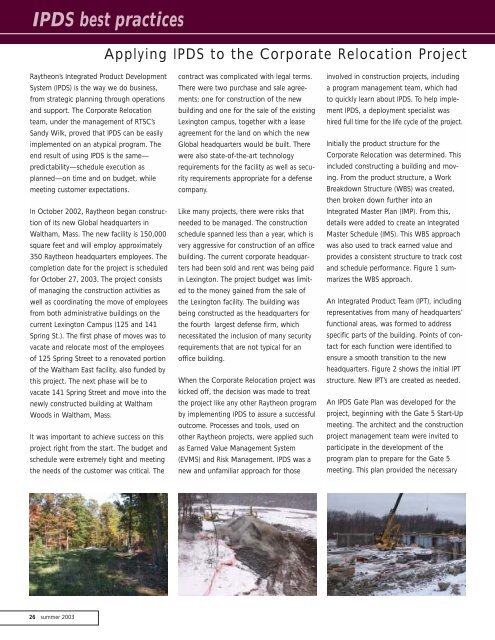INTEGRATED MISSION SOLUTIONS DD(X ... - Raytheon
INTEGRATED MISSION SOLUTIONS DD(X ... - Raytheon
INTEGRATED MISSION SOLUTIONS DD(X ... - Raytheon
You also want an ePaper? Increase the reach of your titles
YUMPU automatically turns print PDFs into web optimized ePapers that Google loves.
IPDS best practices<br />
<strong>Raytheon</strong>’s Integrated Product Development<br />
System (IPDS) is the way we do business,<br />
from strategic planning through operations<br />
and support. The Corporate Relocation<br />
team, under the management of RTSC’s<br />
Sandy Wilk, proved that IPDS can be easily<br />
implemented on an atypical program. The<br />
end result of using IPDS is the same—<br />
predictability—schedule execution as<br />
planned—on time and on budget, while<br />
meeting customer expectations.<br />
In October 2002, <strong>Raytheon</strong> began construction<br />
of its new Global headquarters in<br />
Waltham, Mass. The new facility is 150,000<br />
square feet and will employ approximately<br />
350 <strong>Raytheon</strong> headquarters employees. The<br />
completion date for the project is scheduled<br />
for October 27, 2003. The project consists<br />
of managing the construction activities as<br />
well as coordinating the move of employees<br />
from both administrative buildings on the<br />
current Lexington Campus (125 and 141<br />
Spring St.). The first phase of moves was to<br />
vacate and relocate most of the employees<br />
of 125 Spring Street to a renovated portion<br />
of the Waltham East facility, also funded by<br />
this project. The next phase will be to<br />
vacate 141 Spring Street and move into the<br />
newly constructed building at Waltham<br />
Woods in Waltham, Mass.<br />
It was important to achieve success on this<br />
project right from the start. The budget and<br />
schedule were extremely tight and meeting<br />
the needs of the customer was critical. The<br />
26 summer 2003<br />
Applying IPDS to the Corporate Relocation Project<br />
contract was complicated with legal terms.<br />
There were two purchase and sale agreements;<br />
one for construction of the new<br />
building and one for the sale of the existing<br />
Lexington campus, together with a lease<br />
agreement for the land on which the new<br />
Global headquarters would be built. There<br />
were also state-of-the-art technology<br />
requirements for the facility as well as security<br />
requirements appropriate for a defense<br />
company.<br />
Like many projects, there were risks that<br />
needed to be managed. The construction<br />
schedule spanned less than a year, which is<br />
very aggressive for construction of an office<br />
building. The current corporate headquarters<br />
had been sold and rent was being paid<br />
in Lexington. The project budget was limited<br />
to the money gained from the sale of<br />
the Lexington facility. The building was<br />
being constructed as the headquarters for<br />
the fourth largest defense firm, which<br />
necessitated the inclusion of many security<br />
requirements that are not typical for an<br />
office building.<br />
When the Corporate Relocation project was<br />
kicked off, the decision was made to treat<br />
the project like any other <strong>Raytheon</strong> program<br />
by implementing IPDS to assure a successful<br />
outcome. Processes and tools, used on<br />
other <strong>Raytheon</strong> projects, were applied such<br />
as Earned Value Management System<br />
(EVMS) and Risk Management. IPDS was a<br />
new and unfamiliar approach for those<br />
involved in construction projects, including<br />
a program management team, which had<br />
to quickly learn about IPDS. To help implement<br />
IPDS, a deployment specialist was<br />
hired full time for the life cycle of the project.<br />
Initially the product structure for the<br />
Corporate Relocation was determined. This<br />
included constructing a building and moving.<br />
From the product structure, a Work<br />
Breakdown Structure (WBS) was created,<br />
then broken down further into an<br />
Integrated Master Plan (IMP). From this,<br />
details were added to create an Integrated<br />
Master Schedule (IMS). This WBS approach<br />
was also used to track earned value and<br />
provides a consistent structure to track cost<br />
and schedule performance. Figure 1 summarizes<br />
the WBS approach.<br />
An Integrated Product Team (IPT), including<br />
representatives from many of headquarters’<br />
functional areas, was formed to address<br />
specific parts of the building. Points of contact<br />
for each function were identified to<br />
ensure a smooth transition to the new<br />
headquarters. Figure 2 shows the initial IPT<br />
structure. New IPT’s are created as needed.<br />
An IPDS Gate Plan was developed for the<br />
project, beginning with the Gate 5 Start-Up<br />
meeting. The architect and the construction<br />
project management team were invited to<br />
participate in the development of the<br />
program plan to prepare for the Gate 5<br />
meeting. This plan provided the necessary
















